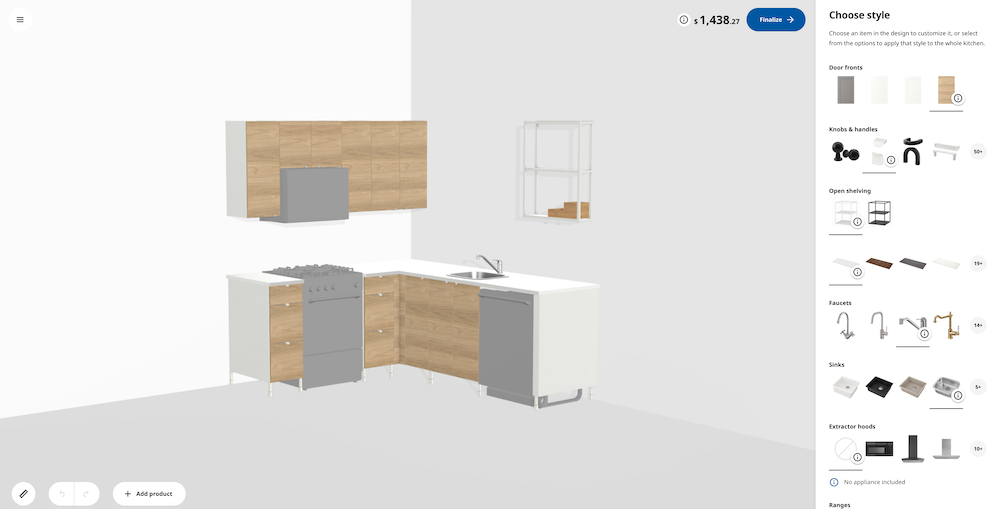The number of customers buying furniture and home goods online is steadily growing.
Between the growth of digital shopping options like buy online, pick up in store (BOPIS) and the rise of artificial intelligence (AI) tools that support a wide range of digital shopping experiences, brands must prepare to meet these new digital demands.
Offering customers an engaging online experience using technology can help them get the information they need to make final buying decisions.
Here are five tips for furniture and home goods brands to bring the in-store experience online.
Tip 1: Take Showrooms Online
Home and garden shoppers are driven by experiences, which is why many choose to go in-store to see products in person. Feeling the weight of a wine glass, sitting on a couch in a showroom, checking the firmness of a mattress — these experiences are what make showrooms so crucial for shoppers.
But brands can bring these showroom floor experiences online.
The global furniture and home goods retailer IKEA, for example, has successfully transitioned its in-store showroom experience to its direct-to-consumer (D2C) site. With its mobile app, customers can use augmented reality (AR) to see what products look like in their homes in real time.
The IKEA Home Planner allows customers to build virtual rooms using their own home dimensions and decorate using products from the retailer. Once the layouts are created, customers can then purchase the products within the rooms on the IKEA website.

Image Source: IKEA
Tip 2: Offer a Wide Range of Engaging Product Content
Stop building boring product pages. Consider the in-store experiences that helped you make your last furniture and home goods purchase, and use content to recreate that experience online.
From videos highlighting the many features of a new home appliance and image galleries offering glamorous editorial photos to a comparison chart highlighting the various models and their unique characteristics, there are so many ways content can help customers experience products virtually.
Glassware company Libbey, for example, uses "wonderful empty shots, filled shots, lifestyle videos" to highlight its products' quality and unique features, says Ryan Griffith, senior director of ecommerce at Libbey.
This prioritization of product content helps establish brand quality and gives insights into the real-world application of its products — all virtually.
Tip 3: Enrich Content With Storytelling and Personalization
Storytelling is vital for reaching and engaging customers — and shopping for furniture and home goods products is no exception. Whether your brand sells furniture, home decor, mattresses, or storage solutions, brands can leverage their origin stories and missions to boost conversion.
These stories must also be consistent across sales channels. Whether a brand sells solely on its D2C site or across 20-plus top retailer sites, customers trust brands with consistent content.
Brands can also utilize personalization opportunities to boost engagement. Offering customers recommendations based on their search — such as “you might also like” or “visitors who looked at this product also looked at “ — can help them feel like the experience is personalized to them, pushing them further along the conversion path.
Tip 4: Test AI Ecommerce Tools
AI-based chatbots, virtual assistants, and other AI-based tools are some of the latest innovations driving increased online furniture and home goods shopping. These tools can support the shopping experience and provide customer support and service after the purchase.
Real-time access to sales and support people through chatbots and virtual assistants can mirror the experience of an in-store sales consultant — as long as brands build the chat experience correctly.
Not all brands can have a real person at the other end of a chat 24/7, but advanced AI and other chat technology can enable them to create an equally effective conversation flow that meets customers' needs.
Tip 5: Give Customers Choices
When customers walk into a showroom at a physical store, they can see and touch the home and garden products they are considering. While there is currently no way to duplicate the experience of touch online, there are many other ways brands can build an online experience that parallels the in-store experience.
Customers demand choice. They also want tools that give them the ability to see how products look and might work in their homes. These options can help bring the in-store experience online, helping brands boost conversion and build brand loyalty.
The secret to making these online experiences is having engaging content and consistent messaging live across every priority channel, ensuring brands meet customers wherever they are online.




.svg)